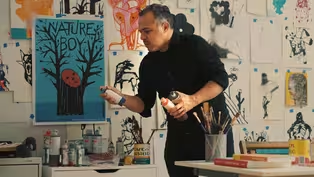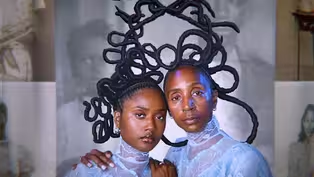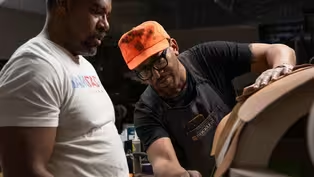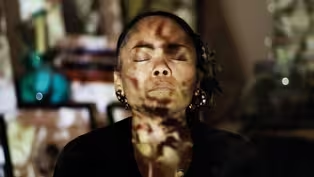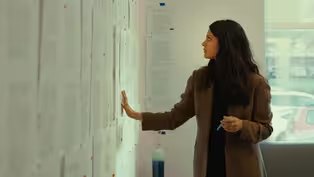
Camille A. Brown: Giant Steps
Special | 15m 25sVideo has Closed Captions
Follow the Broadway choreographer as she elevates the possible with bold explorations of movement.
Follow the 5-time Tony-nominated director and choreographer of Broadway’s Gypsy and Hell’s Kitchen as she elevates the possible with bold explorations of everyday movement, and African Diasporic dance. The film foregrounds Brown’s visionary talent from her Queens, New York neighborhood to the Broadway stage, television and movie screens, and schools around the world.
Problems playing video? | Closed Captioning Feedback
Problems playing video? | Closed Captioning Feedback
Support for American Masters is provided by the Corporation for Public Broadcasting, AARP, Rosalind P. Walter Foundation, Judith and Burton Resnick, Blanche and Hayward Cirker Charitable Lead Annuity Trust, Koo...

Camille A. Brown: Giant Steps
Special | 15m 25sVideo has Closed Captions
Follow the 5-time Tony-nominated director and choreographer of Broadway’s Gypsy and Hell’s Kitchen as she elevates the possible with bold explorations of everyday movement, and African Diasporic dance. The film foregrounds Brown’s visionary talent from her Queens, New York neighborhood to the Broadway stage, television and movie screens, and schools around the world.
Problems playing video? | Closed Captioning Feedback
How to Watch American Masters
American Masters is available to stream on pbs.org and the free PBS App, available on iPhone, Apple TV, Android TV, Android smartphones, Amazon Fire TV, Amazon Fire Tablet, Roku, Samsung Smart TV, and Vizio.
Buy Now
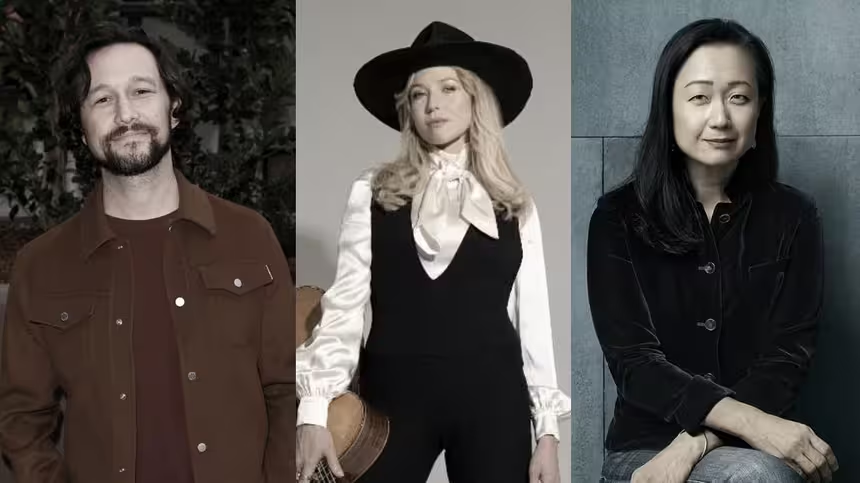
A front row seat to the creative process
How do today’s masters create their art? Each episode an artist reveals how they brought their creative work to life. Hear from artists across disciplines, like actor Joseph Gordon-Levitt, singer-songwriter Jewel, author Min Jin Lee, and more on our podcast "American Masters: Creative Spark."Providing Support for PBS.org
Learn Moreabout PBS online sponsorshipMore from This Collection
Edel Rodriguez: Freedom is a Verb
Video has Closed Captions
Discover this portrait of the Cuban-American graphic artist and graphic novelist Edel Rodriguez. (17m 14s)
House of Aama: Threads of Legacy
Video has Closed Captions
Explore the creative process and familial narrative behind acclaimed fashion label House of Aama. (15m)
Norman Teague: Love Reigns Supreme
Video has Closed Captions
Follow furniture maker and conceptual artist Norman Teague as he prepares for a solo exhibition. (16m 23s)
Danielle Scott: Ancestral Call
Video has Closed Captions
Follow Danielle Scott as she makes art that explores the wretched pain and beauty of her ancestors. (15m 44s)
Gioncarlo Valentine: Exposures
Video has Closed Captions
Photographer Gioncarlo Valentine documents intimacy as a radical act of self-exploration. (18m 13s)
Sarah Thankam Mathews: After All This
Video has Closed Captions
Follow author Sarah Thankam Mathews as pressure mounts to follow up her acclaimed debut novel. (15m 38s)
Providing Support for PBS.org
Learn Moreabout PBS online sponsorship(vehicles rumbling) (upbeat music) - When you're the first or second or it hasn't happened in a long time, I think that there's a tremendous pressure because you're taking all the hits.
They have this idea like the glass that you're shattering, but like, the glass is also falling on you, and it's also cutting you.
As you are shattering and pushing through those barriers, you're getting cut, so it's a powerful feeling, but I also have bruises, too.
(upbeat music continues) (atmospheric music) I've had so many times where I went for a grant and I was literally told, "Oh, you're not gonna get that, you're not at that level yet," and I got it.
I was told, "Oh, you're not going to be a part of that series because, you know, they normally do traditional choreographers."
What is the definition of traditional choreographers?
You know, it almost feels like a code word for white male choreographers.
But I was able to do that series, and more than once.
So I was always shy about wanting to create my own voice because I didn't think I had that in me.
(upbeat music) (upbeat music continues) (upbeat music continues) When I was first starting to choreograph, I didn't have a process.
So, really coming and having dancers and musicians, I was able to create a process.
(upbeat music continues) I get in there and I listen.
It's a lot of listening.
(upbeat music continues) When I first started creating and really being serious about creating my own voice, I was in a rehearsal space, and I sat down and I said, "Camille, don't get up unless something comes from you and it's an idea that you know is from you, it's not from anyone else."
(upbeat music continues) (performers clapping) (performers laughing) My dance company is home base.
You know, there's nothing like it.
As the director, I am my own editor.
It really is the place where I create my vision through my lens, what I wanna see.
I get to create the culture that I want to have.
I get to be with dancers that I'm extremely inspired by.
(upbeat music) (performers chattering) Let's try that with incorporating that, and then let's start on the right leg for the clap.
(performers clapping) Step on the right.
Three, four, and clap.
(performers clapping) Five, six, seven, eight (indistinct).
No, you can fall out of it.
We'll do that tomorrow.
Thank you.
(upbeat music) - [Lorraine] She's a Queens girl.
She was born and raised in Queens.
We both like to say South Jamaica, Queens.
And very, very connected with always wanting to give back and always wanting to represent well our people.
You know, so that's been really, really a hallmark of a lot of her work.
You know, she takes into consideration where she came from, how she was raised, and just making sure that whatever she shares is true to the people, that people can relate to it.
She'd be in front of the TV jumping around, dancing, but I still wasn't making that connection with putting her in dance school yet.
But then after a while, and she'd be choreographing things to the cartoons, and I said, "That's interesting."
So I tried other things, but she never showed the same interest as she did in dancing, and the same discipline.
There was never a time that I had any problem getting her up to go to dance class.
She was up, she got her things together, and she was there.
(upbeat music) - Debbie Allen has been a shero of mine.
Seeing her as a young girl really inspired me to keep pushing and keep going for my dreams.
The fact that she has taken her career and made it so expansive, from being a dancer to a choreographer, to a director, to a director for television, producer, director, film, she made me see that things can be limitless.
I can strive for whatever I wanna be, regardless of whether people tell me it's possible or not.
(upbeat music) (upbeat music continues) - [Lorraine] There was a spark about Carolyn.
She was so caring, so loving, really cared about the kids, and Camille loved it immediately.
- Come on in.
- Thank you.
- Oh, goodness.
- We were trying to work.
- This is Camille, Tissa, Sherrine.
- Yes.
- I think that a lot of my process now is really inspired by you and Brian, because you not only really taught us about the dance and how important it was for us to be strong in our body and performance, but you also taught us about work ethic, too.
Like, don't talk, always listen.
Like, when the teacher speaks, like, you listen.
Know everybody's parts.
- Yes.
Knowing everybody's part.
Right, definitely, - Yeah, I tell my dancers that.
- You should know every piece of the choreography.
- Yes.
- [Carolyn] Her roots started here with Afro-Cuban dance, and then we started with West African dance.
Camille took it to a new level in researching and getting down into the roots of her people.
So when you look at the works that Camille has created, you always see Mother Earth, always.
No matter what she's doing, it always goes back, and it's deeply rooted.
Choreography here used to be only certain people could do certain things.
Camille is living proof that now it's open to everybody.
(gentle music) - [Lorraine] Now she's dancing for herself, she's dancing for the pure love of it.
I think she understands now that she does have a way to communicate to people.
(gentle music) - [Camille] You see African, you see step, you see modern, you see hip hop, you see jazz, but it's all like a pot of stew, and there are all these ingredients, but then when you take it out, it's a very specific soup.
And I feel like with my creative identity, I'm making it specifically me.
(upbeat music) (upbeat music continues) (performers clapping and chattering) - That was really nice.
- Then I was thinking they do different, like, after they go clap, two, three, four, and then, like, they start different gestures.
(upbeat music) - We've seen gestural work in a lot of different things throughout the dance trajectory.
(upbeat music) Her gestural work is Black.
Camille is interested in tradition, upholding the legacy of Blackness.
- There's definitely pressure, because everybody is watching and because I'm on several platforms.
All of those platforms, there are people that are watching, and it's interesting when people say, "Oh, I saw your work through opera."
It's amazing to me and it's exciting, but also, there's the pressure that I put on myself naturally, but then the pressure that I feel from the outside, too.
(upbeat music) - If I had to describe a show with Camille that for me, personally, felt like it was like the shift, it would be "The Groove to Nobody's Business."
And so that was pretty much her way of playing with people on the subway and her observation of what is it like taking a train?
And so I remember her giving us all this choreography, and she wanted to dig a little bit deeper, to say, "Okay, well, how can we make this look real as possible?"
So the challenge for us was to take away all the tools that we have as performers and just be yourselves.
(upbeat music) - It was a fun collaboration.
It was a very smart collaboration.
This was a woman's version, Ma Rainey's version, of what Black sensuality was, and not some Cotton Club idea of what beauty was.
So I engaged Camille in these conversations and described, you know, the type of women I was looking for for the chorus, and she brought them.
Viola, the dancers, Camille, myself, we were all working in service of telling that story.
You're on a journey, and there's commerce and then there's creativity, and then there's fame, and then there's the hard work, and Camille seems very strong and very focused and very driven.
I hope she can protect herself and protect the wonder of telling stories through movement.
- I didn't necessarily believe that it was possible for me to direct and choreograph for Broadway, because the last Black woman to do it was Katherine Dunham, and that was 67 years ago.
(upbeat music) All I can do is hope.
I don't wanna necessarily place myself and say I am doing this for Black women.
I think that's also a trap.
(upbeat music) All I can do is hope that I provide just, like, when I saw and see Marlies Yearby and Dianne McIntyre, and see them working in theater, having their own companies, I can only hope that the generation after is seeing myself and other choreographers, other Black female choreographers and directors like me, and wanting to do that.
(upbeat music) (performers chattering) ♪ Leavin' so you ♪ better get on board ♪ ♪ 'Cause we're leavin' ♪ for the Promise' Lan' ♪ ♪ An' you better ♪ get on board ♪ ♪ So you better get on board ♪ ♪ 'Cause we're leavin' ♪ for the Promise' Lan' ♪ ♪ An' you better ♪ get on board ♪ ♪ So you better get on board ♪ - [Indira] It's her perspective.
Being a Black woman in America, I think that was the natural connection for me, and so her approach to different themes and content was really important, and I felt connected strongly to that.
And then, of course, it's the actual choreography, the movement sensibility, it jived with my own personal lived experience, and I've always found that to be so beautiful, and it's really been a representation of all that she is and all that she can be.
- [Camille] This is the first time on Broadway that I've actually had the opportunity to share my observations and what I grew up seeing and being a part of, being born and raised in New York City, and putting that on a Broadway stage.
And so to have that kind of opportunity feels like I'm introducing the theater community to another way, a more expanded side of me in terms of, like, my movement language.
♪ New York ♪ Every time I have an experience, I always grow from it, and whatever I've learned, I can incorporate into the next experience.
So that's why I wanna take, like, my signature, is just, you see an evolution, you see the progression of Camille, but you never see a difference, it's always Camille.
It evolves, it grows, it stretches and expands, but it's always me.
(upbeat music) (upbeat music) (upbeat music continues) (upbeat music continues) (upbeat music continues) (no audio) (clapperboard clacks)
Support for PBS provided by:
Support for American Masters is provided by the Corporation for Public Broadcasting, AARP, Rosalind P. Walter Foundation, Judith and Burton Resnick, Blanche and Hayward Cirker Charitable Lead Annuity Trust, Koo...

